Prepare for Evacuation with a 72-hour Emergency Go Bag (Free Printable)
This website may earn commissions from purchases made through links in this post.
As the last few years have shown, you never know when an emergency will strike. And while it’s essential to prepare your home and have an emergency kit, an evacuation grab bag is also important to have ready to go if you need it.
I learned the hard way that you should have an emergency bag ready to go in case of evacuation.
I was living in Sydney, right on the edge of a National Park, during the Black Christmas bushfires in 2002.
We had spent the day in the city, blissfully unaware that the bushfires were near where we lived.
Getting on the bus to return home, the driver said, “Sorry, I’m not going that far. That area has been cut off by the bushfires.”
We walked the rest of the way home, relieved that our house was still standing despite the chaos around us. Only the motorway and the volunteer firefighters stood between the bushfire and us.
We were told: “pack up your things quickly and be ready to evacuate on command.”
What were we packing during this stressful time?
Not things that would have actually been useful.
Now I live in coastal Queensland. Bushfires aren’t a threat to us where we are, but cyclones, storms and floods are. Fast forward to 2022, and Australians (and the world) have seen a lot of disasters over the past few years.
It doesn’t matter where you live; even if you live in the middle of a big city, there’s always the possibility you may have to face a natural disaster or other emergencies.
Are you prepared for emergencies and evacuation?
What is an Emergency Go Bag?
It’s an emergency situation. You have to get out NOW. You’re stressed, maybe panicked. You’re worried about getting out safely. You’re worried about your family, your home, your possessions.
What do you grab in this situation?
That’s where a grab-and-go bag comes in. Otherwise known as an emergency go bag, evacuation bag, relocation bag, or 72-hour kit, this is a bag you have already packed with things you need for 72 hours if you ever have to evacuate your house suddenly.
By planning and preparing ahead of time, you’re taking a little bit of the panic out of a stressful situation. And you can be assured you’re taking the things you need to get by in an evacuation.
Why 72 hours/three days?
That’s approximately how long it can take to get help after a widespread disaster and for evacuation centres to get up and running, although it can take longer.
That means, for 72 hours or more after a disaster, you may be on your own with no organised assistance. Your emergency kit is there to help you get by during this time.
An emergency go-bag differs from a home emergency kit, although you might keep your stuff together. An emergency kit has supplies you need if you’re staying at home, while your go bag is for if you have to relocate.
What is the Best Bag for an Emergency Go Bag?
The best kind of bag for your emergency relocation kit is a backpack that you can easily carry.
You want something big enough to hold your emergency supplies but not so big you can’t carry or maneuver it. You want to keep it light enough to carry.
Consider some of the scenarios we’ve seen on the news lately: people being evacuated from floods in canoes or from fires on the back of trucks.
Your bags should be big enough to hold a few days’ worth of supplies but small enough so it’s not cumbersome. Here’s an example of a family’s grab-and-go bags.
Each person in the household (who is old enough) should have their own grab bag. Some items are more appropriate for a parent’s bag than a child’s – make the call depending on your family.
Ideally, your bags should be waterproof. Although the best bag is the one you have, not the one you intend to get, so use what you have. You can keep things in your bag waterproof (and organised) by storing them in zip-lock bags.
Store your grab-and-go bags where they are easily accessible and close to the front door or main exit.
Consider storing a 72-hour kit in your car or transferring your kit to your car if you know there’s a storm or bushfire on the way. Remember, you may be at work when an emergency occurs.
What Goes In Your Evacuation Bag
There are a lot of suggestions about what *could* go in your evacuation bag, but not all of them will be relevant. And remember, you’ve got to be able to carry your bag! So although the list below is long, you won’t need everything on it!
The list is written in order of importance. The first essential items are ones suggested by the Red Cross.
Some things, like sturdy shoes, can be kept nearby without needing to go into your bag. Some people suggest keeping shoes and a flashlight near your bed in case you need to evacuate suddenly at night.
Other items can be kept in your home’s emergency kit, which should also be easily accessible. If you have access to a vehicle, you can easily load your kit into your car with your relocation bag. If you don’t have a vehicle, you’ve still got all the essentials packed in your bag.
Essential Emergency Go-Bag Items
These emergency evacuation items are the ones suggested by the US Red Cross.
Water
The official recommendation is to have three days’ worth of water per person or 10 litres each.
Let’s just have a look at how much 10 litres of water is:
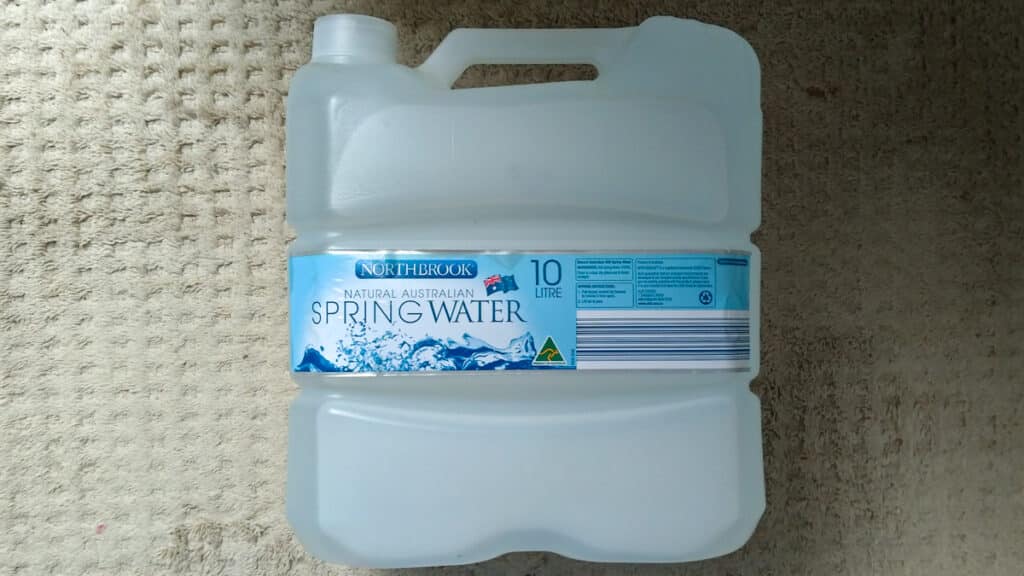
That’s too heavy to carry around in a backpack, along with other stuff.
We keep plenty of water at home but only put a few litres in our emergency bag. We supplement with water purification tablets, which are easier to carry. If time allows, we can still pack extra water in the car.
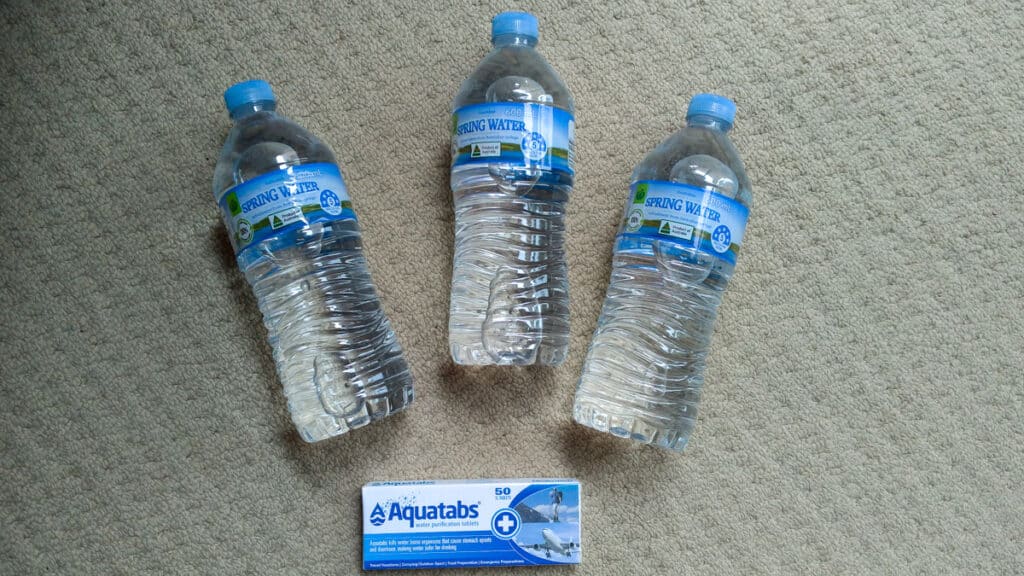
Electrolyte powder or tablets can also be a good idea if you live in a hot climate.
Food
You want to pack three days’ supply of non-perishable food that’s light, easy to prepare and preferably doesn’t require lots of water or cooking facilities.
Consider things like protein bags, tuna sachets, chicken sachets, soup packets, instant coffee (you seriously don’t want withdrawals in an emergency situation), powdered milk, crackers, instant noodles, instant rice, peanut butter, dried fruit, nuts, beef jerky, or instant oatmeal.
You can spend a lot of money on ‘survival’ food packs, but to stick to a budget, it’s better to buy food you would normally eat so that you can swap it out regularly and nothing gets wasted. All of the above can be purchased from a normal supermarket or Aldi.
It’s a good idea to pack your food up in waterproof zip-lock bags in 3-day lots. So each zip-lock bag would include breakfast, lunch, dinner and snacks. Include the food you would actually eat.
Don’t forget to pack a spoon, cup, and plate (recycle a plastic plate and cutlery). It’s best not to pack canned foods because of the weight and the need for an opener.
Flashlight
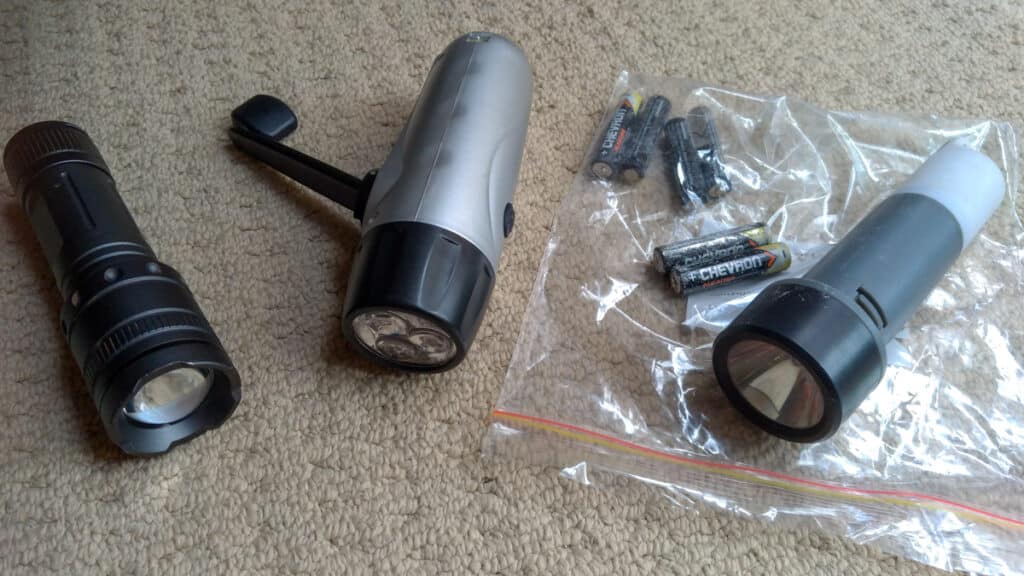
You can get a battery-operated or hand-cranked torch and either keep one in your bag or have one beside your bed to grab.
If you’re storing a battery-operated torch, don’t leave the batteries in the torch; keep them separately in case they leak (as they did in the photo above).
Radio (Battery or Hand Cranked)
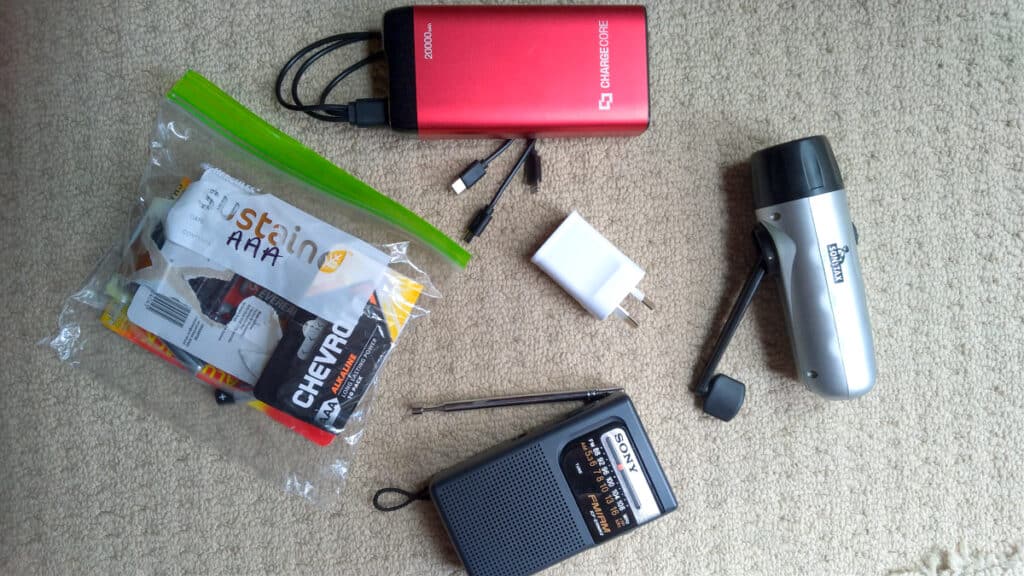
While most of us get our emergency updates with our mobile phones, either online or by text, a radio is helpful to keep up with emergency information if the mobile phone service is cut.
Keep your radio in a waterproof zip-lock bag and as with the torch, store the batteries separately.
Spare Batteries
If you are using a battery-powered torch or radio, it’s a good idea to pack spare batteries. Check which size battery your devices need first.
Phone Chargers and/or Power Bank
If you’re packing a charger, make sure you have a cord with the correct plug for your phone (our family are on three different connections at the moment).
A power pack can come in handy to charge your phone if there is no power or access to a power point, but you will need to check it regularly to ensure it still has charge.
First Aid kit
Pack a personal first aid kit with antiseptic spray and cream, sunscreen, and plenty of mozzie spray. While not essential, we pack snake bite bandages too, because, you know, Australia.
A Multi-Purpose Tool
A multi-purpose tool will cover you for just about any job, whether opening a can or cutting wood for a fire.
Spare Cash
Useful if EFTPOS machines are down or the power is out. With cash, you can still buy things. It’s better to carry some money in small denominations rather than large notes in case you can’t get change.
Sanitation Items
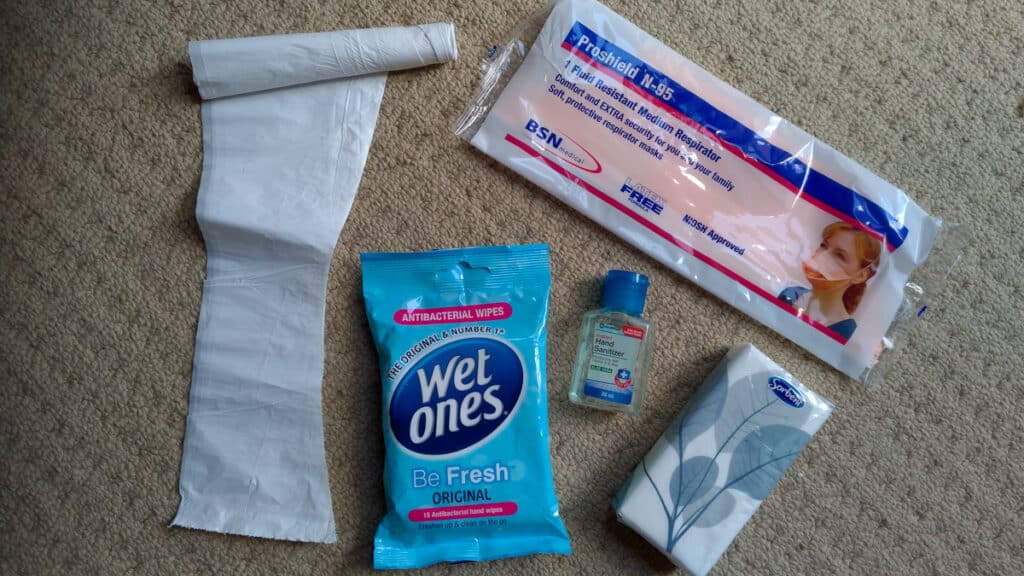
Sanitation items include hand sanitiser, garbage bags, wet wipes, masks, tissues or toilet paper, and female sanitary items if needed.
Essential Medications
If you or your family members have chronic conditions that require medication, then it’s vital to have a seven-day supply of medications on hand for emergencies and copies of any scripts so you can fill prescriptions if needed.
Personal Documents
It’s a good idea to carry copies of personal documents in case the ones at home can’t be accessed or they are destroyed. And while you can keep copies of these on a USB stick or upload them to a secure online storage service, if you don’t have power or internet access, hard copies will be invaluable.
Personal documents might include passports, driver’s licences, wills, birth and marriage certificates, medical history, photos of home and valuables, land titles, mortgage papers, insurance papers, and bank statements.
Emergency Plan, Contact Information, and a Map of the Area
Include a card with emergency contact information for each family member and other emergency contacts that don’t live close by.
An emergency ID card is also a good idea. It should include your name, address, mobile number, emergency contacts, family meeting location, and important medical information.
In the case of children, your (the parent’s) name and a current family photo are also helpful in case of separation.
Emergency Blanket
Emergency blankets are small and lightweight and can be used to stay warm or as a shelter.
A Whistle
Useful for drawing attention to you in the dark.
A Change of Clothes
Imagine wading through flood waters and then not having dry clothes to change into. If you’re ever in that situation, you’ll be glad you’ve packed a clean set of clothes in a waterproof zip-lock bag.
Consider the climate you live in and pack accordingly. Layers are always a good idea; a cheap t-shirt, a long-sleeve shirt, old jeans, underwear, and plenty of socks. In cold climates, pack extra items for warmth. In hot climates, you can always cut a tracksuit into shorts.
Camping and outdoor wear are great because they are lightweight, repel water, dry quickly and fold down small.
To save money, pack old (but still wearable) clothes you have on hand or buy second-hand clothes. Check every six months or so that the clothes still fit, especially for children.
You may also want to include thongs (flip flops), a plastic rain poncho and/or rain jacket, and a sun hat.
Other Useful But Non-Essential Items for Your Emergency Go Bag
If you’ve packed a grab bag with the essential items above, you’re already doing more than the vast majority of people.
Below are some other things you might want to consider:
- Garden and rubber gloves – in case you need to clear debris
- Lighter or matches
- Safety goggles
- Toiletries bag (toothbrush, toothpaste, soap, feminine hygiene products, chapstick, deodorant, comb)
- Household chlorine bleach and a medical dropper – to treat water.
- Toilet paper
- Spare glasses or contact lenses
- Spare house and car keys
- Lighter or matches
- Spare zip lock bags
- Pen and paper
- Entertainment – if you’re spending a few days in an emergency shelter, a book or a pack of cards will come in handy.
- USB stick/storage of photographs and important documents
- Duct tape
A lot of these things will be too heavy to carry or you won’t have enough room in your backpack.
They can go in your home emergency kit. For more information, check out the article Emergency Preparedness on a Budget.
Other Useful Items to Grab if You Have Time and Transport
There are some things that would be good in an evacuation but won’t fit on your relocation bag. If you have time and can transport them, you might also want to grab these items.
To save time, store important items together in an easily accessible place. It’s also a good idea to create a checklist of extra stuff you want to take and where it is stored to make it easier to pack when stressed.
- Sturdy shoes
- Sleeping bags and/or blankets
- Purse
- Baby bag
- Extra shoes
- External hard drive/backup
- Laptop
- Home emergency kit
- Extra food and water
- Extra Clothes
- Valuables
- Photos
- Air Mattress and pump
Grab-and-Go Bag Items For Children
For babies and young children, don’t forget to include:
- Nappies
- Formula and a bottle if using
- Baby food
- Comfort item
- Toys or entertainment
Grab-and-Go Bag Items For Pets
If you have pets, include:
- Pet food and bowl
- Leash
- Carrier
- Medication
- ID
Maintaining Your Grab and Go Bag
You will need to check your grab bag every four to six months so that it stays current.
I use the Google Calendar app and ToDoist to schedule reminders in advance for everything, so I don’t forget.
Things to check when you’re updating your emergency go bag include:
- Is the food and water still in date? Eat it before it goes bad to reduce waste, and swap it out for newer food. Tap water you bottle yourself has a shelf-life of six months.
- Do the spare clothes still fit?
- Are the medications still in date? Again, schedule reminders on your calendar, so you use this medicine before it goes out of date.
- Is your ID and important information up to date?
How to Save Money on Your Emergency Go Bag
Money is tight for everyone, so spending money on stuff ‘in case of emergency’ is the last thing any of us want. So how do we prepare for emergencies on a budget?
Here are some tips for saving money on your grab bag:
- Make your own personalised kit based on the disasters in your area and your family circumstances – while you can buy ready-made go bags, you probably won’t need all their stuff
- Stick to the essential items and don’t worry about unessential items
- Use what you already have on hand but reorganise it, so it’s easily accessible.
- Look in second-hand stores, Gumtree, and Facebook Marketplace for sturdy clothes, bags, blankets, and other, gently used emergency items.
- Build your emergency kit over time, looking for sale items
- Ask for things like a flashlight or radio as gifts
- Store your own water in clean bottles instead of buying it. Here’s how to sanitise bottles.
- Check out army surplus stores for savings.
Printable Emergency Go Bag Checklist
To make it easier, I’ve made a free printable emergency bag PDF checklist to tick off. Download it by clicking the image below.
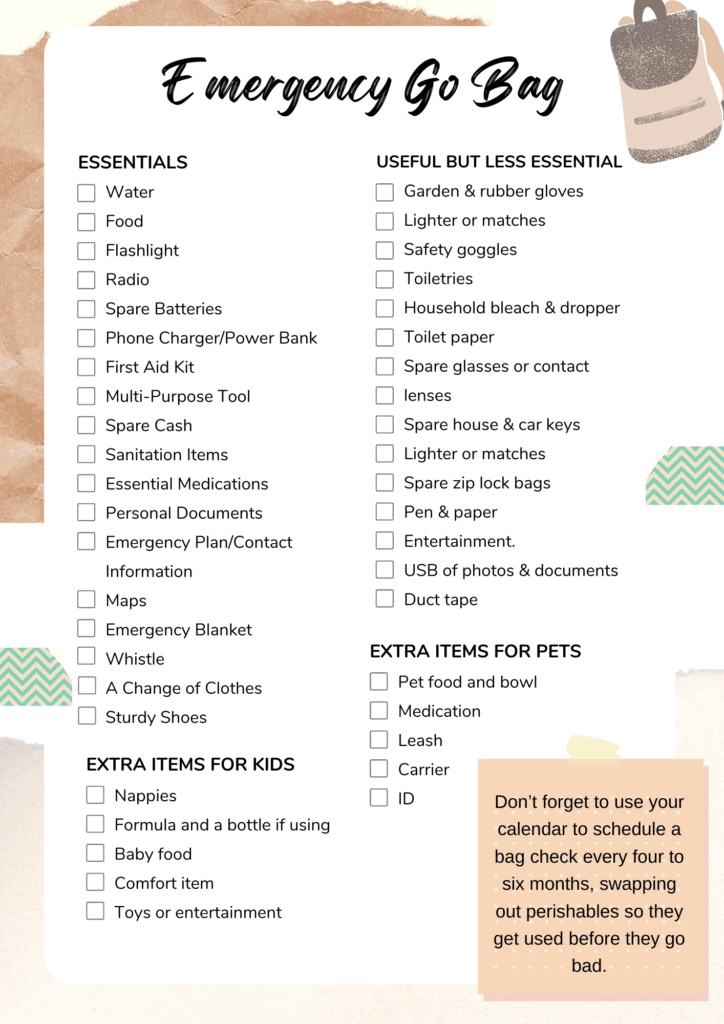
Hopefully, we’ll never need our emergency grab bags. But if we ever do, our future selves will be glad we took the time and effort to put time together.

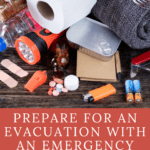
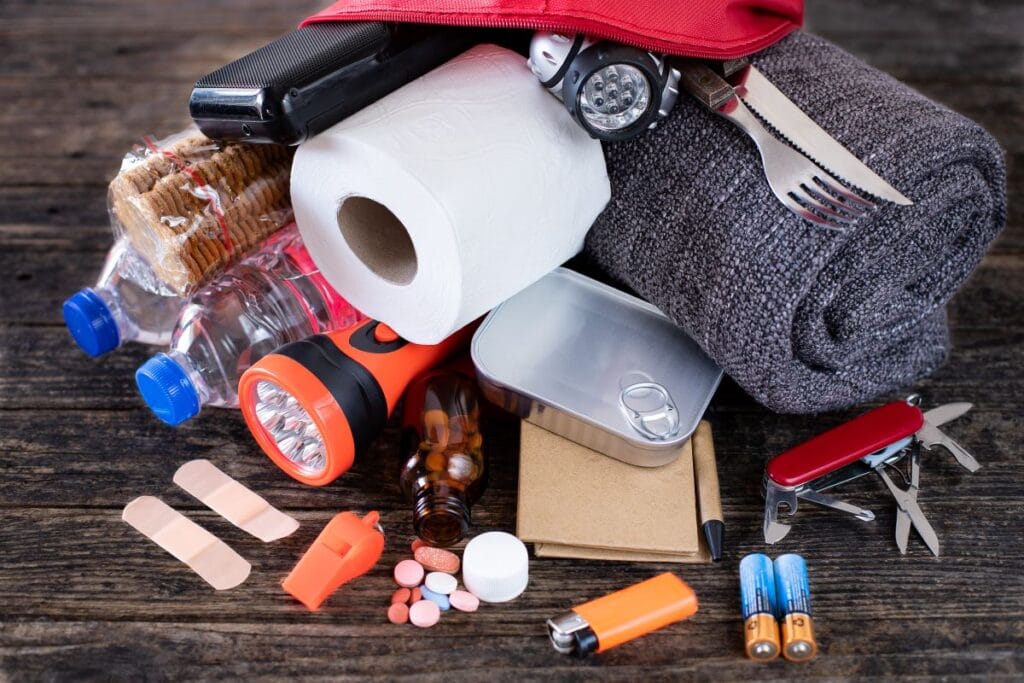
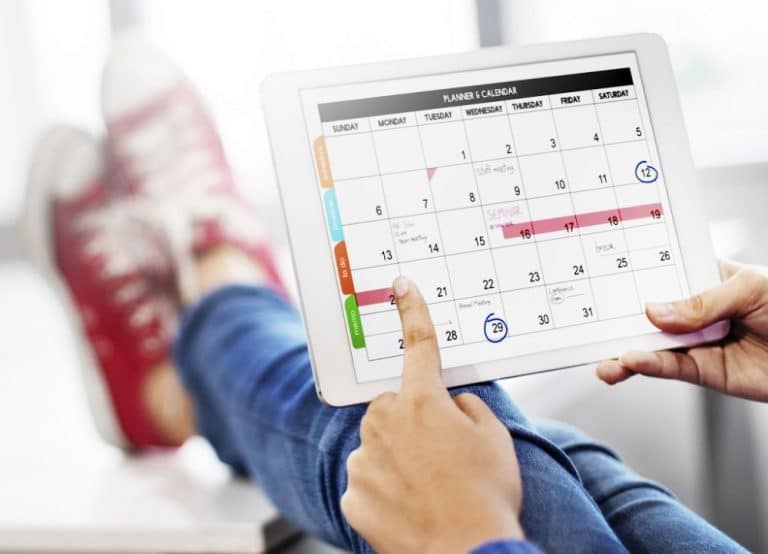

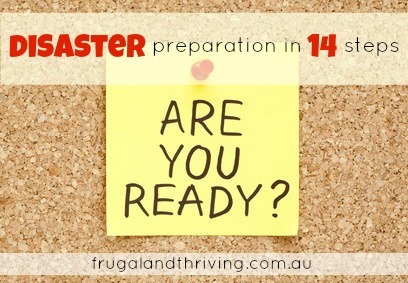

Last week I had to evacuate my home due to bushfire. Thank God I have my emergency kit and my fire plan all set out. It came in handy.
I hope everything turned out ok and your house was ok.
We go through our 72 hour kits each year (pick a day that works for you- ours is the first weekend in October- General Conference weekend) and replace perishable items.
Great tip, thanks! :)
This is the first list that actually gave me examples of what to pack
Eg canned food, certain clothing items. I have looked at MANY online preperatiom lists because I’m paranoid amd anxious about the future. This list is the first one that actually made me feel secure, calm and prepared after reading it
Thank you so much
I have added a folding umberella it would be handy for rain and a shelter from sun. I have packed my things in a pull along shopping trolley bag it will get lighter as I drink the water and eat the food. I will have a small bag on top for the dog’
S kit.
What a great idea!! The umbrella and the shopping trolley.